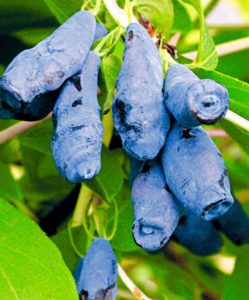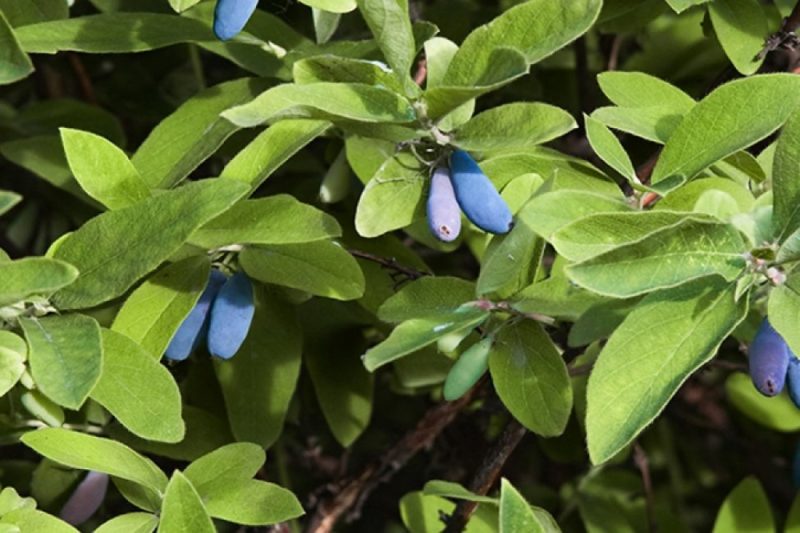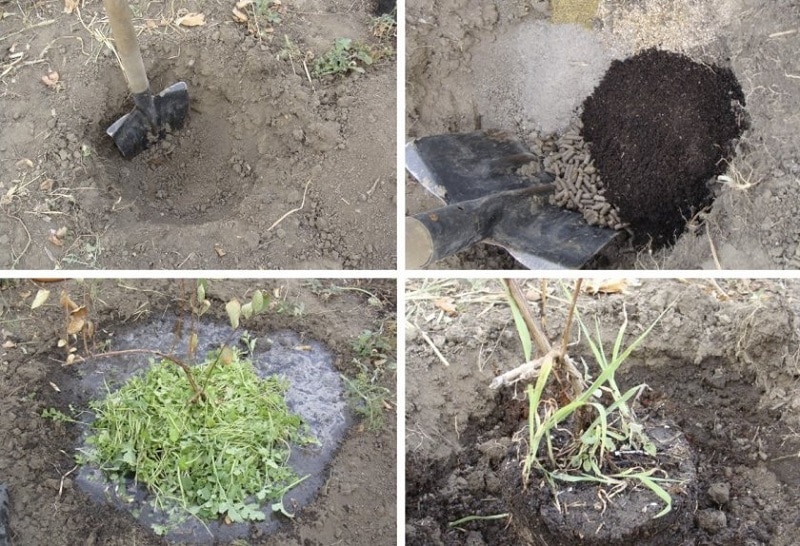Large-fruited hardy honeysuckle variety Bazhovskaya
Honeysuckle Bazhovskaya is hardy, tasty and large-fruited. It combines the sweet taste and high yield of Altai species. But choosing the right variety is only half the battle. It is also important to know the intricacies of cultivating the crop and providing it with proper care.
Description of the honeysuckle variety Bazhovskaya
Just 20 years ago, few gardeners knew about the existence of this variety. Now, in almost every farmstead you can find a bush with delicious Bazhovskaya honeysuckle berries.
Origin and development
The variety was bred by Ural breeders by crossing Kamchatka and Altai varieties.
The purpose of creating Bazhovskaya honeysuckle is to get rid of the bitterness in the taste of the berries, which was present in the first generation varieties. The variety was included in the State Register list in 1999.
Characteristics, appearance, taste

Honeysuckle Bazhovskaya grows as a wide spreading bush formed by many thin long branches. By bending, they create a beautiful crown for the plant.
The bark on the shoots is dark green with a purple tint, slightly pubescent on young shoots. With proper care, honeysuckle reaches 2 m in height.
The leaves are large, lanceolate, and richly green. The fruits at maturity become barrel-shaped and dark blue in color. Their surface is bumpy. The weight of each berry reaches an average of 1 g, sometimes 1.8 g.
Both experts and consumers note the excellent taste of the fruit.The pulp is juicy, aromatic, absolutely devoid of bitterness inherent in most varieties. Tasters and breeders rated the taste of the berry 5 points.
Features of application
The fruits are universal. They are suitable for fresh consumption and for processing.
The berries are used to make jams, preserves and compotes.
Productivity and fruiting
Plants begin to bear fruit at 3 years of age. 1.5-2.5 kg of berries are harvested from one bush.
Ripening period
The berries ripen 40 days after the start of flowering. In the southern regions, the harvest is ready for harvest in early June. In all other areas, the fruits ripen by mid-June.
Resistance to diseases and pests
Honeysuckle Bazhovskaya almost never gets sick. It is also rarely attacked by pests.
Resistance to cold and drought
The variety tolerates frosts down to -45°C. In dry times, regular watering is required.
With a lack of moisture, the berries develop bitterness.
Suitable regions
Bazhovskaya is best suited for cultivation in the Volga region, the Southern Urals, the middle zone and the Moscow region.
Advantages and disadvantages of the variety

The main advantages of the Bazhovskaya variety:
- large fruit;
- frost and drought resistance;
- high productivity;
- resistance of flower buds to return frosts.
Flaws:
- during drought, with insufficient watering, the berries become bitter;
- due to average crumbling, the crop is harvested in 2-3 doses;
- bushes require regular thinning.
Difference from other varieties and hybrids
A distinctive feature is a tasting rating of 5 out of 5. Almost no other variety has such a rating.
Agricultural technology
Honeysuckle Bazhovskaya is not picky. But its important plant correctly and fulfill care requirements.
Choosing a place in the garden and preparing holes
The place should be sunny, humid and protected from drafts.
A hole is dug with a diameter and depth of 50 cm. 1 bucket of humus and a 1 liter jar of ash are poured into it. Also add 2 handfuls of Agrovit-kor fertilizer.
Preparing for landing
Before planting, seedlings are inspected and all damaged branches are removed. The roots are shortened to 30 cm and immersed in a bucket with earthen mash.
Soil requirements
There are no special requirements for the soil. The main thing is that the soil is not swampy or sandy.
Landing scheme and rules

The distance between the bushes is maintained at 2 m, since when they are closed, the yield decreases.
Planting process:
- An earthen mound is made in the planting hole.
- Spread the roots of the seedling over it and cover it with soil. The root collar should be 5 cm deep into the ground.
- The earth is compacted and watered with 2 buckets of water.
- The tree trunk circle is mulched.
Features of cultivation
Seedlings of this variety take root well. The main thing is to provide them with proper care.
Water the honeysuckle as the top layer of soil dries. Fertilizers are applied 3 times:
- During flowering, feed with a mixture of urea and ammonium nitrate.
- When the berries ripen fertilize slurry.
- After harvesting, superphosphate or potassium salt is added.
Mature bushes every autumn trimmed. Remove all diseased and damaged branches.
Pollinators
Honeysuckle Bazhovskaya is a self-fertile crop that requires cross-pollination to produce fruit.
The best pollinators are considered Enchantress, Sineglazka and Long-fruited.
Disease and pest control
Bushes are sometimes affected by aphids, scale insects and honeysuckle sawflies. Also, if not properly cared for, plants suffer from powdery mildew, septoria, and table rot.
When pests or diseases prune damaged shoots. After this, the entire bush is treated with fungicides.
Preparing for winter
In the middle zone and southern regions, honeysuckle is not covered. In the northern regions of the country, the tree trunk circle is covered with a layer of compost 10-15 cm thick.
Reproduction
Bushes are propagated by cuttings or rooting annual shoots.
When growing, a shoot 20 cm long is taken from a cutting and planted in moist soil at an angle of 45°.
When propagating by layering, the lower young branch is buried. This place is watered regularly. After a few months, the branch forms its own root system. It is separated from the mother bush and replanted.
Difficulties in growing
Providing proper care should not be difficult. Only in the southern regions is it important to ensure that the soil does not dry out.
Harvesting
Fruit ripening occurs in waves, so the harvest is harvested several times.
The ripeness of berries is determined by their blue color. After this, they wait about another week for the fruits to gain sweetness.
Spread a film under the bush and shake the plant. After this, the fallen berries are collected.
Reviews from experienced gardeners
Summer residents use Bazhovskaya honeysuckle for decorative purposes and note the high taste of the fruit.
Mikhail, Kazan: “Several years ago I imprisoned Bazhovskaya. The berries are very healthy and tasty. I’m planning to make a hedge out of the bushes.”
Anastasia, Omsk: “I have little experience in growing Bazhovskaya. I bought several seedlings last year. Almost all the plants have taken root. They even produced a small harvest. The berries are sweet and juicy."
Conclusion
Honeysuckle Bazhovskaya is an unpretentious crop that produces tasty and healthy berries. The main thing is to regularly water the bushes and apply fertilizers.With proper care, the plant will bear fruit for 25-30 years.